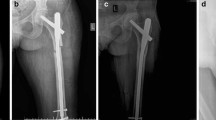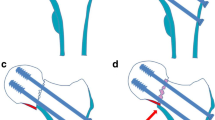Abstract
Background
Femoral fractures are common in children between 2 and 12 years of age and 75% of the lesions affect the femoral shaft. Traction followed by a plaster cast is universally accepted as conservative treatment. We compared primary hip spica with closed reduction and fxation with retrogradely passed crossed Rush pins for diaphyseal femur fracture in children. The hypothesis was that Rush pin might provide better treatment with good clinical results in comparison with primary hip spica.
Materials and Methods
Fifty children with femoral fractures were evaluated; 25 of them underwent conservative treatment using immediate hip spica (group A) and 25 were treated with crossed retrograde Rush pins (group B). The patients ages ranged from 3 to 13 years (mean of 9 years).
Results
Mean duration of fracture union was 15 weeks in group A and 12 weeks in group B. Mean duration of weight bearing 14 weeks in group and 7 weeks in group B. Mean hospital stay was 4 days in group A and 8 days in group B. Mean followup period in group A was 16 months and group B was 17 months. Complications such as angulation, shortening, infection were compared.
Conclusions
Closed reduction and internal fxation with crossed Rush pins was superior in terms of early weight bearing and restoration of normal anatomy.
Similar content being viewed by others
Change history
01 October 2016
This article has been retracted. Please see the Retraction Notice for more detail: https://doi.org/10.4103/0019-5413.189615
Referenes
Flynn JM, Schwend RM. Management of pediatric femoral shaft fractures. J Am Acad Orthop Surg 2004;12:347–59.
Kirby RM, Winquist RA, Hansen ST Jr. Femoral shaft fractures in adolescents: A comparison between traction plus cast treatment and closed intramedullary nailing. J Pediatr Orthop 1981;1:193–7.
Mann DC, Weddington J, Davenport K. Closed ender nailing of femoral shaft fractures in adolescents. J Pediatr Orthop 1986;6:651–5.
Ligier JN, Metaizeau JP, Prévot J, Lascombes P. Elastic stable intramedullary nailing of femoral shaft fractures in children. J Bone Joint Surg Br 1988;70:74–7.
Nascimento FP, Santili C, Akkari M, Waisberg G, Reis Braga SD, de Barros Fucs PM. Short hospitalization period with elastic stable intramedullary nails in the treatment of femoral shaft fractures in school children. J Child Orthop 2010;4:53–60.
Kasser JR, Beuty JH. Femoral shaft fractures. In: Beaut JH, Kasser JR, editors. Rockwood and Wilkins’ fractures in children, 5th ed. Philadelphia: Lippincott Williams and Wilkins 2001; p. 948.
Flynn JM, Hresko T, Reynolds RA, Blasier RD, Davidson R, Kasser J. Titanium elastic nails for pediatric femur fractures: A multicenter study of early results with analysis of complications. J Pediatr Orthop 2001;21:4–8.
Staheli LT, Sheridan GW. Early spica cast management of femoral shaft fractures in young children. A technique utilizing bilateral fixed skin traction. Clin Orthop Relat Res 1977;126:162–6.
Hughes BF, Sponseller PD, Thompson JD. Pediatric femur fractures: Effects of spica cast treatment on family and community. J Pediatr Orthop 1995;15:457–60.
Mahar AT, Lee SS, Lalonde FD, Impelluso T, Newton PO. Biomechanical comparison of stainless steel and titanium nails for fixation of simulated femoral fractures. J Pediatr Orthop 2004;24:638–41.
Lee SS, Mahar AT, Newton PO. Ender nail fixation of pediatric femur fractures: A biomechanical analysis. J Pediatr Orthop 2001;21:442–5.
Fricka KB, Mahar AT, Lee SS, Newton PO Biomechanical analysis of antegrade and retrograde flexible intramedullary nail fixation of pediatric femoral fractures using a synthetic bone model. J Pediatr Orthop 2004;24:167–71.
Rathjen KE, Riccio AI, De La Garza D. Stainless steel flexible intramedullary fixation of unstable femoral shaft fractures in children. J Pediatr Orthop 2007;27:432–41.
Wall EJ, Jain V, Vora V, Mehlman CT, Crawford AH. Complications of titanium and stainless steel elastic nail fixation of pediatric femoral fractures. J Bone Joint Surg Am 2008;90:1305–13.
Cramer KE, Tornetta P 3rd, Spero CR, Alter S, Miraliakbar H, Teefey J. Ender rod fixation of femoral shaft fractures in children. Clin Orthop Relat Res 2000; 376119–23.
Lee ZL, Chang CH, Yang WE, Hung SS. Rush pin fixation versus traction and casting for femoral fracture in children older than seven years. Chang Gung Med J 2005;28:9–15.
Simanovsky N, Porat S, Simanovsky N, Eylon S. Close reduction and intramedullary flexible titanium nails fixation of femoral shaft fractures in children under 5 years of age. J Pediatr Orthop B 2006;15:293–7.
Bopst L, Reinberg O, Lutz N. Femur fracture in preschool children: Experience with flexible intramedullary nailing in 72 children. J Pediatr Orthop 2007;27:299–303.
Heinrich SD, Drvaric DM, Darr K, MacEwen GD. The operative stabilization of pediatric diaphyseal femur fractures with flexible intramedullary nails: A prospective analysis. J Pediatr Orthop 1994;14:501–7.
Vrsansky P, Bourdelat D, Al Faour A. Flexible stable intramedullary pinning technique in the treatment of pediatric fractures. J Pediatr Orthop 2000;20:23–7.
Author information
Authors and Affiliations
Corresponding author
About this article
Cite this article
Ruhullah, M., Singh, H.R., Shah, S. et al. RETRACTED ARTICLE: Hip spica versus Rush pins for management of femoral diaphyseal fractures in children. IJOO 48, 488–494 (2014). https://doi.org/10.4103/0019-5413.139860
Published:
Issue Date:
DOI: https://doi.org/10.4103/0019-5413.139860




